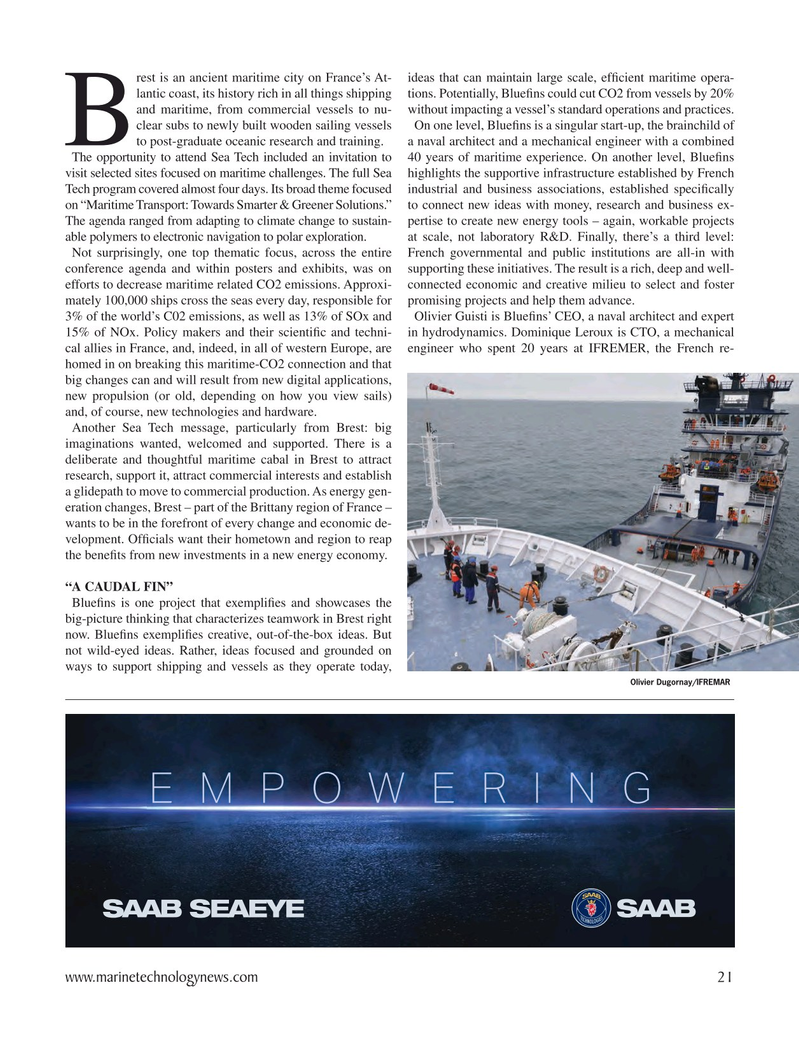
Page 21: of Marine Technology Magazine (November 2022)
Read this page in Pdf, Flash or Html5 edition of November 2022 Marine Technology Magazine
rest is an ancient maritime city on France’s At- ideas that can maintain large scale, ef? cient maritime opera- lantic coast, its history rich in all things shipping tions. Potentially, Blue? ns could cut CO2 from vessels by 20% and maritime, from commercial vessels to nu- without impacting a vessel’s standard operations and practices. clear subs to newly built wooden sailing vessels On one level, Blue? ns is a singular start-up, the brainchild of
Bto post-graduate oceanic research and training. a naval architect and a mechanical engineer with a combined
The opportunity to attend Sea Tech included an invitation to 40 years of maritime experience. On another level, Blue? ns visit selected sites focused on maritime challenges. The full Sea highlights the supportive infrastructure established by French
Tech program covered almost four days. Its broad theme focused industrial and business associations, established speci? cally on “Maritime Transport: Towards Smarter & Greener Solutions.” to connect new ideas with money, research and business ex-
The agenda ranged from adapting to climate change to sustain- pertise to create new energy tools – again, workable projects able polymers to electronic navigation to polar exploration. at scale, not laboratory R&D. Finally, there’s a third level:
Not surprisingly, one top thematic focus, across the entire French governmental and public institutions are all-in with conference agenda and within posters and exhibits, was on supporting these initiatives. The result is a rich, deep and well- efforts to decrease maritime related CO2 emissions. Approxi- connected economic and creative milieu to select and foster mately 100,000 ships cross the seas every day, responsible for promising projects and help them advance.
3% of the world’s C02 emissions, as well as 13% of SOx and Olivier Guisti is Blue? ns’ CEO, a naval architect and expert 15% of NOx. Policy makers and their scienti? c and techni- in hydrodynamics. Dominique Leroux is CTO, a mechanical cal allies in France, and, indeed, in all of western Europe, are engineer who spent 20 years at IFREMER, the French re- homed in on breaking this maritime-CO2 connection and that big changes can and will result from new digital applications, new propulsion (or old, depending on how you view sails) and, of course, new technologies and hardware.
Another Sea Tech message, particularly from Brest: big imaginations wanted, welcomed and supported. There is a deliberate and thoughtful maritime cabal in Brest to attract research, support it, attract commercial interests and establish a glidepath to move to commercial production. As energy gen- eration changes, Brest – part of the Brittany region of France – wants to be in the forefront of every change and economic de- velopment. Of? cials want their hometown and region to reap the bene? ts from new investments in a new energy economy.
“A CAUDAL FIN”
Blue? ns is one project that exempli? es and showcases the big-picture thinking that characterizes teamwork in Brest right now. Blue? ns exempli? es creative, out-of-the-box ideas. But not wild-eyed ideas. Rather, ideas focused and grounded on ways to support shipping and vessels as they operate today,
Olivier Dugornay/IFREMAR
EMPOWERING www.marinetechnologynews.com 21
MTR #8 (18-33).indd 21 11/28/2022 3:07:50 PM

 20
20

 22
22
